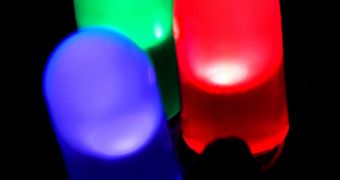A new type of polarization-matched light-emitting diode (LED) device has been obtained by researchers at the Rensselaer Polytechnic Institute, following intense efforts of coming up with a type of LED that illuminates brighter and consumes less energy than its predecessors. Featuring a light output increase of 18 percent, as well as 22 percent more energy efficiency, the new type of diodes are sure to have a say on the market over the next few years.
Over the course of the research, one of the most common problems was to prevent “drooping,” a phenomenon not yet fully understood, but which is believed to be connected with the fact that LED devices lose electrons when subjected to high-density currents. This causes them to become ineffective at times when the grid is over-saturated with this type of power, and to work best when low-density ones are available.
“This droop is under the spotlight since today’s high-brightness LEDs are operated at current densities far beyond where efficiency peaks. This challenge has been a stumbling block, because reducing the current densities to values where LEDs are more efficient is unacceptable. Our new LED, however, which has a radically re-designed active region, namely a polarization-matched active region, tackles this issue and brings LEDs closer to being able to operate efficiently at high current densities,” explains E. Fred Schubert, Rensselaer Wellfleet Senior Constellation Professor of Future Chips.
Schubert, the leader of the project, also works as head of the Smart Lighting Engineering Research Center at the University, which is funded by the National Science Foundation. In a paper published online this week in the journal Applied Physics Letters, the scientist explains the exact method he and his colleagues used to avoid the droop in the new Gallium Indium Nitride/Gallium Nitride (GaInN/GaN) layers they applied to the active regions of the LED.
In theory, polarization matching – the principal applied here – was thought to reduce both electron loss and efficiency droop. So, all the team had to do was actually build such a LED device, to test if their beliefs held. Luckily, they did, which means that the future could see their invention lighting the streets of tomorrow.

 14 DAY TRIAL //
14 DAY TRIAL //